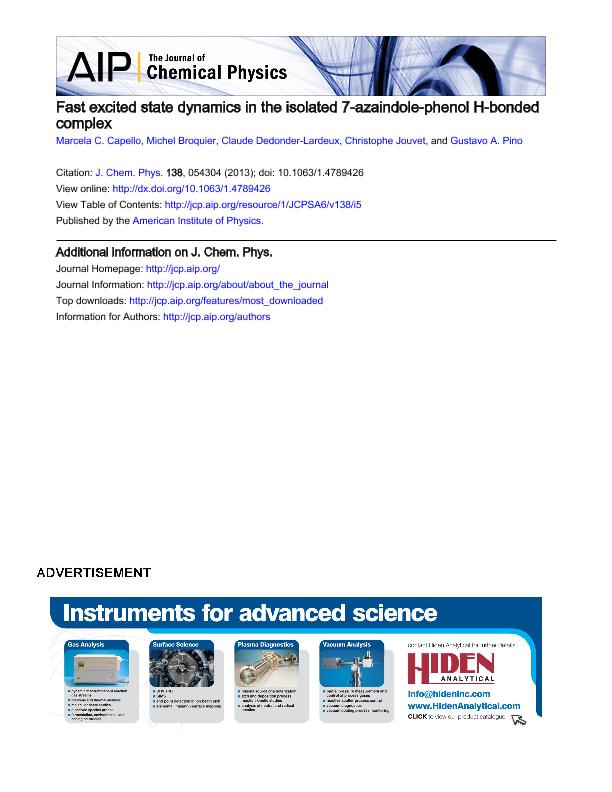Mostrar el registro sencillo del ítem
dc.contributor.author
Capello, Marcela Carolina

dc.contributor.author
Broquier, Michel
dc.contributor.author
Dedonder Lardeux, Claude
dc.contributor.author
Jouvet, Christophe
dc.contributor.author
Pino, Gustavo Ariel

dc.date.available
2017-09-22T20:55:12Z
dc.date.issued
2013-02
dc.identifier.citation
Capello, Marcela Carolina; Broquier, Michel; Dedonder Lardeux, Claude; Jouvet, Christophe; Pino, Gustavo Ariel; Fast excited state dynamics in the isolated 7-azaindole-phenol H-bonded complex; American Institute of Physics; Journal of Chemical Physics; 138; 2-2013; 1-10; 054304
dc.identifier.issn
0021-9606
dc.identifier.uri
http://hdl.handle.net/11336/25007
dc.description.abstract
The excited state dynamics of the H-bonded 7-azaindole-phenol complex (7AI-PhOH) has been studied by combination of picosecond pump and probe experiments, LIF measurements on the nanosecond time scale and ab initio calculations. A very short S1 excited state lifetime (30 ps) has been measured for the complex upon excitation of the 00 0 transition and the lifetime remains unchanged when the ν6 vibrational mode (00 0 + 127 cm−1) is excited. In addition, no UV-visible fluorescence was observed by exciting the complex with nanosecond pulses. Two possible deactivation channels have been investigated by ab initio calculations: first an excited state tautomerization assisted by a concerted double proton transfer (CDPT) and second an excited state concerted proton electron transfer (CPET) that leads to the formation of a radical pair (hydrogenated 7AIH• radical and phenoxy PhO• radical). Both channels, CDPT and CPET, seem to be opened according to the ab initio calculations. However, the analysis of the ensemble of experimental and theoretical evidence indicates that the excited state tautomerization assisted by CDPT is quite unlikely to be responsible for the fast S1 state deactivation. In contrast, the CPET mechanism is suggested to be the non-radiative process deactivating the S1 state of the complex. In this mechanism, the lengthening of the OH distance of the PhOH molecule induces an electron transfer from PhOH to 7AI that is followed by a proton transfer in the same kinetic step. This process leads to the formation of the radical pair (7AIH•···PhO•) in the electronically excited state through a very low barrier or to the ion pair (7AIH+···PhO−) in the ground state. Moreover, it should be noted that, according to the calculations the πσ* state, which is responsible for the H loss in the free PhOH molecule, does not seem to be involved at all in the quenching process of the 7AI-PhOH complex.
dc.format
application/pdf
dc.language.iso
eng
dc.publisher
American Institute of Physics

dc.rights
info:eu-repo/semantics/openAccess
dc.rights.uri
https://creativecommons.org/licenses/by-nc-sa/2.5/ar/
dc.subject
Laser Dynamics
dc.subject
Picoseconds
dc.subject
Dimer Complex
dc.subject.classification
Otras Ciencias Químicas

dc.subject.classification
Ciencias Químicas

dc.subject.classification
CIENCIAS NATURALES Y EXACTAS

dc.title
Fast excited state dynamics in the isolated 7-azaindole-phenol H-bonded complex
dc.type
info:eu-repo/semantics/article
dc.type
info:ar-repo/semantics/artículo
dc.type
info:eu-repo/semantics/publishedVersion
dc.date.updated
2017-09-21T19:05:43Z
dc.journal.volume
138
dc.journal.pagination
1-10; 054304
dc.journal.pais
Estados Unidos

dc.description.fil
Fil: Capello, Marcela Carolina. Consejo Nacional de Investigaciones Científicas y Técnicas. Centro Científico Tecnológico Conicet - Córdoba. Instituto de Investigaciones en Físico-química de Córdoba. Universidad Nacional de Córdoba. Facultad de Ciencias Químicas. Instituto de Investigaciones en Físico-química de Córdoba; Argentina
dc.description.fil
Fil: Broquier, Michel. Universite Paris Sud; Francia
dc.description.fil
Fil: Dedonder Lardeux, Claude. Universite Paris Sud; Francia
dc.description.fil
Fil: Jouvet, Christophe. Universite Paris Sud; Francia
dc.description.fil
Fil: Pino, Gustavo Ariel. Consejo Nacional de Investigaciones Científicas y Técnicas. Centro Científico Tecnológico Conicet - Córdoba. Instituto de Investigaciones en Físico-química de Córdoba. Universidad Nacional de Córdoba. Facultad de Ciencias Químicas. Instituto de Investigaciones en Físico-química de Córdoba; Argentina
dc.journal.title
Journal of Chemical Physics

dc.relation.alternativeid
info:eu-repo/semantics/altIdentifier/doi/http://dx.doi.org/10.1063/1.4789426
dc.relation.alternativeid
info:eu-repo/semantics/altIdentifier/url/http://aip.scitation.org/doi/10.1063/1.4789426
Archivos asociados
